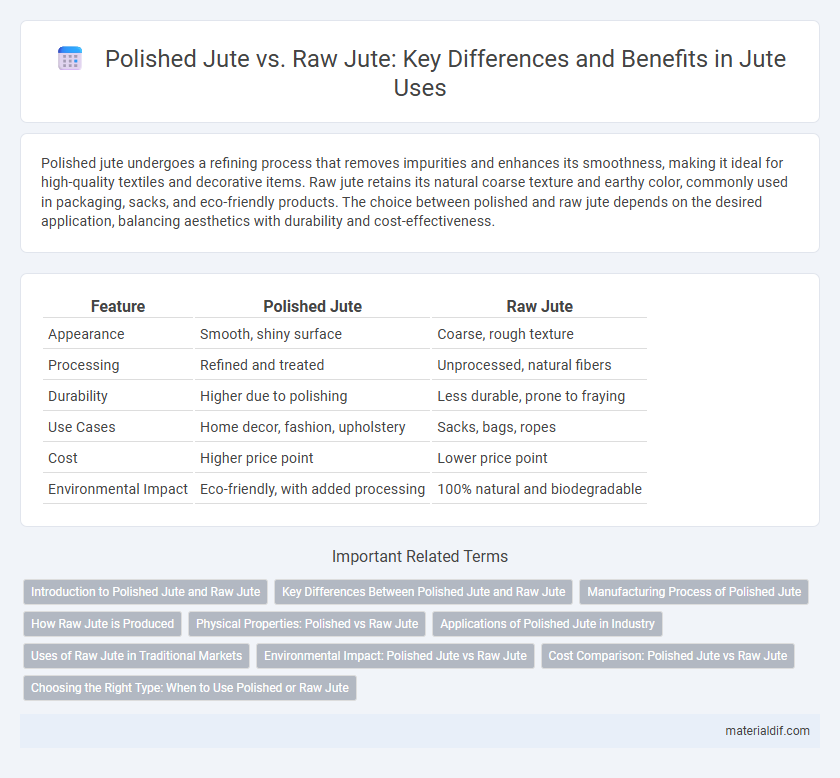Polished jute undergoes a refining process that removes impurities and enhances its smoothness, making it ideal for high-quality textiles and decorative items. Raw jute retains its natural coarse texture and earthy color, commonly used in packaging, sacks, and eco-friendly products. The choice between polished and raw jute depends on the desired application, balancing aesthetics with durability and cost-effectiveness.
Table of Comparison
| Feature | Polished Jute | Raw Jute |
|---|---|---|
| Appearance | Smooth, shiny surface | Coarse, rough texture |
| Processing | Refined and treated | Unprocessed, natural fibers |
| Durability | Higher due to polishing | Less durable, prone to fraying |
| Use Cases | Home decor, fashion, upholstery | Sacks, bags, ropes |
| Cost | Higher price point | Lower price point |
| Environmental Impact | Eco-friendly, with added processing | 100% natural and biodegradable |
Introduction to Polished Jute and Raw Jute
Polished jute undergoes a refining process that enhances its texture, luster, and durability, making it ideal for high-quality textiles and home decor applications. Raw jute, on the other hand, is harvested directly from the jute plant and retains a coarse, fibrous structure suitable for industrial use such as sacks and ropes. The distinction between polished and raw jute lies in their respective processing techniques, which significantly impact their appearance, strength, and end-use versatility.
Key Differences Between Polished Jute and Raw Jute
Polished jute is processed to have a smoother texture and enhanced shine compared to raw jute, which retains its coarse, natural appearance. The key differences include the level of refinement, color brightness, and softness, with polished jute being more suitable for decorative applications while raw jute is preferred for industrial uses. Polished jute undergoes additional treatments like washing and buffing, whereas raw jute is used in its natural, untreated form.
Manufacturing Process of Polished Jute
Polished jute undergoes an additional refining process beyond raw jute, involving meticulous washing, steaming, and brushing to remove impurities and enhance fiber smoothness. This manufacturing process includes the application of natural or synthetic polishing agents that improve the fabric's sheen and texture without compromising its eco-friendly properties. The result is a durable, lustrous material widely used in high-quality textiles and upholstery.
How Raw Jute is Produced
Raw jute is produced by harvesting mature jute plants, which are then subjected to retting, a water-based process that loosens the fibers by breaking down the pectin binding them. After retting, the fibers are stripped, washed, and dried, resulting in raw jute that retains a coarse texture and natural color. This unrefined form serves as the base material for further processing into polished jute through additional cleaning and softening methods.
Physical Properties: Polished vs Raw Jute
Polished jute exhibits a smoother surface texture and higher tensile strength compared to raw jute, enhancing its durability and making it ideal for crafting premium bags and upholstery. Raw jute retains a coarse, fibrous texture with more natural impurities, which contributes to its lower tensile strength but greater absorbency and biodegradability. The physical distinction in fiber fineness and surface finish directly impacts the usability and lifespan of products made from polished versus raw jute fibers.
Applications of Polished Jute in Industry
Polished jute, known for its smooth texture and enhanced durability, is widely used in high-end textile products, upholstery, and biodegradable packaging solutions, offering an eco-friendly alternative to synthetic materials. Its refined finish makes it ideal for decorative items, fashion accessories, and industrial composites, where both strength and aesthetic appeal are crucial. The industrial applications of polished jute also extend to automotive components and geotextiles, leveraging its environmental benefits and performance characteristics.
Uses of Raw Jute in Traditional Markets
Raw jute remains a staple in traditional markets due to its coarse fibers ideal for making sacks, bags, and ropes that offer durability and biodegradability. Unlike polished jute, which is refined for textile production, raw jute is preferred for packaging agricultural products and crafting rustic home decor items. Its affordability and natural texture maintain its demand in rural and artisanal sectors, preserving heritage craftsmanship.
Environmental Impact: Polished Jute vs Raw Jute
Polished jute undergoes additional processing that consumes more energy and water compared to raw jute, increasing its environmental footprint. Raw jute, being minimally processed, retains higher biodegradability and requires fewer chemical treatments, making it a more sustainable option. Choosing raw jute supports lower carbon emissions and less water pollution throughout the production cycle.
Cost Comparison: Polished Jute vs Raw Jute
Polished jute undergoes additional processing steps such as washing, drying, and polishing, which increase its overall production cost compared to raw jute. Raw jute, being unprocessed or minimally processed, remains significantly more affordable and widely used in bulk applications like packaging and textiles. Cost differences between polished and raw jute can range from 20% to 50%, depending on quality and market demand.
Choosing the Right Type: When to Use Polished or Raw Jute
Polished jute offers a smoother texture and enhanced durability, making it ideal for home decor and fashion accessories that require a refined finish. Raw jute retains its coarse, natural fibers, preferred for eco-friendly packaging, agricultural uses, and rustic crafts where authenticity and biodegradability are essential. Selecting between polished and raw jute depends on the desired aesthetic, functionality, and environmental impact of the final product.
Polished Jute vs Raw Jute Infographic

 materialdif.com
materialdif.com